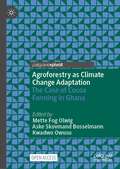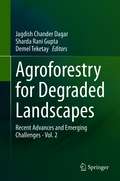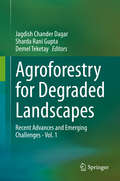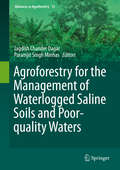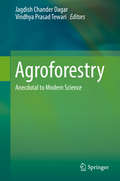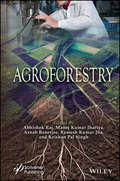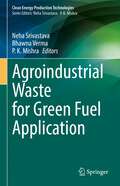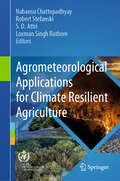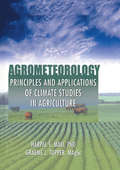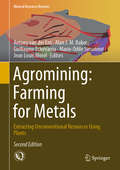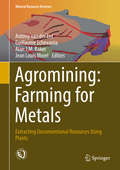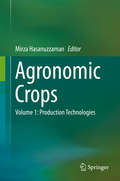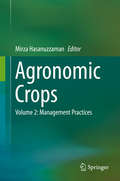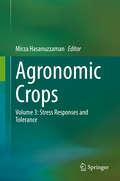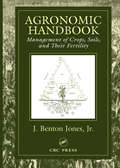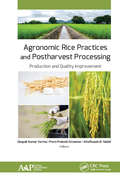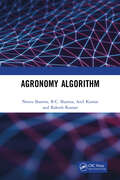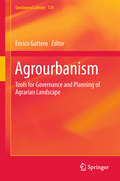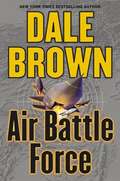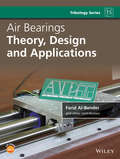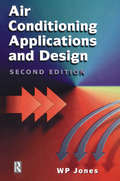- Table View
- List View
Agroforestry and Ecosystem Services
by Shibu Jose Ranjith P. UdawattaThis book is a state-of-the-art compilation of the latest information on ecosystem services of agroforestry. The last two decades have seen a surge in literature on the ecosystem services of sustainable agriculture practices, including that of agroforestry; however, compilation and synthesis of such information from agroforestry have been limited. This book fills that void by bringing in a number of experts from around the world. In addition to presenting the multiple dimensions of ecosystem services provided by major agroforestry practices, the book also offers case studies from both tropical and temperate regions of the world.Information from this book can be used to design land management practices for climate change mitigation, ecosystem benefits, agricultural productivity and sustainability, and for survival and profitability of family farms and to conserve biodiversity. While synthesizing information of the biophysical aspects of ecosystem services, the book also outlines the socioeconomic and policy dimensions, including appropriate incentive models to enhance adoption of agroforestry so that society at large can enjoy these important benefits
Agroforestry as Climate Change Adaptation: The Case of Cocoa Farming in Ghana
by Mette Fog Olwig Aske Skovmand Bosselmann Kwadwo OwusuThis open access book provides multidisciplinary perspectives on the potential of agroforestry to mitigate the negative impacts of climate change on cocoa production. Against the backdrop of increasingly precarious farmer livelihoods, it focuses on cocoa-agroforestry in Ghana – the second largest producer of cocoa in the world. Taking the reader on a journey across experimental plots and on-farm studies, the book delivers a holistic understanding of cocoa-agroforestry. Chapters examine historical yield and climate interactions, the effects of heat and drought on cocoa plants and the role of differing shade trees on soil fertility, yields, pests and diseases. The book discusses the socioeconomics of shade tree management, including cost-benefits, tree rights and competition for natural resources emphasizing policy implications and recommendations.Taking a multidisciplinary approach to climate-agriculture interactions, the book provides an innovative understanding of agroforestry and perennial cropping systems that goes beyond the Ghanaian cocoa belt. It is of relevance to students, researchers, farmers, practitioners and policymakers working with agroforestry and climate change adaptation.This is an open access book.
Agroforestry for Degraded Landscapes: Recent Advances and Emerging Challenges - Vol. 2
by Jagdish Chander Dagar Sharda Rani Gupta Demel TeketayThis book presents various aspects of agroforestry research and development, as well as the latest trends in degraded landscape management. Over the last four decades, agroforestry research (particularly on degraded landscapes) has evolved into an essential problem-solving science, e.g. in terms of sustaining agricultural productivity, improving soil health and biodiversity, enhancing ecosystem services, supporting carbon sequestration and mitigating climate change. This book examines temperate and tropical agroforestry systems around the world, focusing on traditional and modern practices and technologies used to rehabilitate degraded lands. It covers the latest research advances, trends and challenges in the utilization and reclamation of degraded lands, e.g. urban and peri-urban agroforestry, reclamation of degraded landscapes, tree-based multi-enterprise agriculture, domestication of high-value halophytes, afforestation of coastal areas, preserving mangroves and much more. Given its scope, the book offers a valuable asset for a broad range of stakeholders including farmers, scientists, researchers, educators, students, development/extension agents, environmentalists, policy/decision makers, and government and non-government organizations.
Agroforestry for Degraded Landscapes: Recent Advances and Emerging Challenges - Vol.1
by Jagdish Chander Dagar Sharda Rani Gupta Demel TeketayThis book presents various aspects of agroforestry research and development, as well as the latest trends in degraded landscape management. Over the last four decades, agroforestry research (particularly on degraded landscapes) has evolved into an essential problem-solving science, e.g. in terms of sustaining agricultural productivity, improving soil health and biodiversity, enhancing ecosystem services, supporting carbon sequestration and mitigating climate change. This book examines temperate and tropical agroforestry systems around the world, focusing on traditional and modern practices and technologies used to rehabilitate degraded lands. It covers the latest research advances, trends and challenges in the utilization and reclamation of degraded lands, e.g. urban and peri-urban agroforestry, reclamation of degraded landscapes, tree-based multi-enterprise agriculture, domestication of high-value halophytes, afforestation of coastal areas, preserving mangroves and much more. Given its scope, the book offers a valuable asset for a broad range of stakeholders including farmers, scientists, researchers, educators, students, development/extension agents, environmentalists, policy/decision makers, and government and non-government organizations.
Agroforestry for Sustainable Intensification of Agriculture in Asia and Africa (Sustainability Sciences in Asia and Africa)
by Jagdish Chander Dagar Sharda Rani Gupta Gudeta Weldesemayat SileshiThis edited book opens up new vistas for sustainable intensification in agriculture to provide food to ever growing population as well as adapting to the risks of global environmental change. Diverting from conventional agriculture, the book explores new dimensions and concepts that have been identified for future research and development in sustaining agriculture in Asia and Africa regions. The chapters are written by leading researchers and practitioners in the field of agroforestry. The book demonstrates how agroforestry could be instrumental in bringing stability and sustainability in agricultural production. It offers sustainable solutions for the impending problems of climate change, ecosystem degradation, declining agricultural productivity, and uncertain food security. It is an essential resource for students in agroforestry courses, as well as a valuable introduction to the field for professionals in related areas.
Agroforestry for the Management of Waterlogged Saline Soils and Poor-Quality Waters (Advances in Agroforestry #13)
by Jagdish Chander Dagar Paramjit Singh MinhasLand degradation caused by salinity and waterlogging is a global problem afflicting about one billion hectares and endangering the food security of at least 75 countries. Since the social, economic and environmental costs of on and/off-farm reclamation techniques are high, agroforestry is now emerging as a potential tool, not only for arresting salinity and waterlogging, but also for other environmental services like mitigating climate change, sequestering carbon and restoring biodiversity. This publication addresses the vital issues, principles and practices related to rehabilitation using agroforestry and includes many site-specific case studies from a number of the world's typical catchments. Written by leading researchers, the book is a must, not only for scientists whose research interests lie in soil salinity, waterlogging and poor-quality waters, but also policy makers, environmentalists, students, and educationists alike. More importantly, it contributes to reversing the salinity trends and ensuring the livelihoods of resource-poor farming families living in these harsh agro-ecosystems.
Agroforestry to Combat Global Challenges: Current Prospects and Future Challenges (Sustainable Development and Biodiversity #36)
by Eric D. Van Hullebusch Vishnu D. Rajput Hanuman Singh Jatav Tatiana Minkina Asik DuttaThis edited book brings out comprehensive insights on agro-forestry systems to cope up climate change globally. The main essence of this book is to unfurl the positive sides of agri-silvipastoral system to reduce greenhouse gases (GHGs) and temperature. Agro-forestry can be defined as the farming practice combining field crops, perennial trees and livestock. The impact of agro-forestry on ecology is implacable which is thoroughly discussed under different heads in this book. In addition, the book is bundle of different novel sections including tables, graphical representation, and figures showcasing the bright side of agro-forestry system. Furthermore, trees which are important component of boosting socio-economic conditions, especially for the indigenous populations have also been discussed meticulously. Hence, all together this book deciphers an account of agro-forestry practices in society and environment along with the major pros- and cons- of the system. Undoubtedly, this information could enrich the scholarly knowledge for graduate research fellows, teachers, scientists, researchers, and environmentalists in gaining multifaceted information of agro-forestry system in both ecological and economical aspects. Different research highlights will be helpful for the policy makers to implement this novel practice in intensive production systems and harness the maximum benefits out of this.
Agroforestry: Anecdotal To Modern Science (Advances In Agroforestry #10)
by Jagdish Chander Dagar Vindhya Prasad TewariAgroforestry (AF) is a dynamic, ecologically based, natural resources management system that, by integrating trees on farms, ranches, and in other landscapes, diversifies and increases production and promotes social, economic, and environmental benefits for land users. Further, it is receiving increasing attention as a sustainable land-management option worldwide because of its ecological, economic, and social attributes. Advances have been achieved by building on past research accomplishments and expanding AF’s stakeholder base, which now includes private/public partnerships, communities, ecologists, farmers, indigenous peoples, and policymakers in both temperate and tropical countries. <P><P> AF has now been recognized as a valuable problem-solving approach to ensuring food security and rebuilding resilient rural environments. Recent studies have shown that more than 1 billion hectares of agricultural land have more than 10% tree cover. Of this area, 160 million hectares have more than 50% tree cover. Agricultural ecosystems can be further improved through AF to achieve environmental restoration, greater farm productivity, and key ecological services, including climate change mitigation and adaptation for improved rural livelihood. In fact, it is largely considered synonymous with climate smart agriculture and a remedy for many modern environmental challenges. Consequently, AF’s knowledge base is being expanded at a rapid rate, as illustrated by the increasing number and quality of scientific publications on various forms and different aspects of AF. <P> This book offers state-of-the-art information on the fundamental concepts and history of AF and its evolution as a science, presenting a wealth of advanced research results and evaluations relating to different aspects of AF. Accordingly, it will be useful for a broad readership, including students, foresters, farmers, local communities, indigenous peoples, civil society institutions, media, policymakers and the general public.
Agroforestry: Issues And Challenges
by Manoj Kumar Jhariya Arnab Banerjee Abhishek Raj Ramesh Kumar Jha Krishan Pal SinghThis book offers comprehensive insights into the management of agroforestry for livelihood security and sustainable development in the tropics, addressing ecological interactions, productivity, and the monetization of carbon credits, while also outlining a future roadmap and policy challenges. Agroforestry is a brilliant land use farming practice that covers 1.6 billion hectares (78 percent in the tropics and 22 percent in the temperate regions) to enhance plant diversification, productivity, and livelihood across generations, maintaining eco-restoration. It ensures socioeconomic upliftment and a standard livelihood for people along with many ecosystem services for sustainable development under resilient climates, which are today’s key topics popularized among policy makers, stakeholders, scientists, ecologists, and climate supporters in the tropical world. However, more than 75 percent of the world’s poor directly depend on natural resources for their livelihoods. Adopting climate resilient agroforestry not only maximizes productivity and farmers’ socioeconomic status but also mitigates climate change issues through carbon sequestrations for better carbon management in the tropics. This book addresses agroforestry management for livelihood security and sustainable development in the tropics. Readers will earn about ecological interactions and productivity in tropical agroforestry ensuring greater ecosystem services and livelihood resilience under changing climates, as well as building livelihood resilience through monetization of carbon credits in agroforestry in the tropics. Livelihood and sustainability-based policy in agroforestry, its challenges, and a future roadmap are also covered. This volume provides new insights related to updated research, development and extension activities for combating climate change through carbon sequestration to enhance intensify greater productivity, and livelihood and ecosystem services for ensuring the goals of sustainable development.
Agroindustrial Waste for Green Fuel Application (Clean Energy Production Technologies)
by P. K. Mishra Neha Srivastava Bhawna VermaThe book revisit in depth scope of agroindustrial waste for enhancement in biofuels production on practical ground. It explores and discusses various cellulose rich agro-wastes along with low cost, advance technology based options for sustainable biofuels production. Lignocellulosic biomasses are potential producer of biofuels due to renewable nature and huge occurrence. Cellulose is the main polymeric component of these biomasses apart from lignin and hemicellulose. It can be converted into fermentable sugars using cellulase enzyme which can be further converted into the renewable energy sources such as biohydrogen, bioethanol, biogas and butanol. Chapters in this title provide exclusive and critical analysis of specific biofuels production process only from lignocellulosic biomass, based on their type, property, availability, cost and most important sugar or cellulose content along with the simplest process search for converting these biomasses into biofuels to make overall process more simple and economical.It is a useful guide for academician and environmentalist who are working to explore feasible advantages associated with these kinds of waste management and their effective valorization. It is also a great resource for senior undergraduate and graduate students, researchers, professionals, and other interested individuals/groups working in the field of biofuel/bioenergy.
Agrometeorological Applications for Climate Resilient Agriculture
by S. D. Attri Nabansu Chattopadhyay Robert Stefanski Laxman Singh RathoreThis book offers perspectives on more productive, sustainable and resilient modes of agriculture. The chapters highlight successful, evidence-based local and regional practices across the globe that are resulting in more sustainable and viable methods of farming, particularly important within the context of weather variability and climate change. The efficient use of weather and climate services for agricultural applications are fundamental to these efforts. In the past, weather and climate services have not been used to their fullest potential for developing sustainable agriculture. But now more than ever, as this book documents, agrometeorology is an essential tool for current and future food production and security around the world. This book offers strategic recommendations for strengthening the role and availability of agrometeorological services around the globe.
Agrometeorology: Principles and Applications of Climate Studies in Agriculture
by Harpal S. Mavi Graeme J. TupperLearn how the climate can affect crop production! Agrometeorology: Principles and Applications of Climate Studies in Agriculture is a much-needed reference resource on the practice of merging the science of meteorology with the service of agriculture. Written in a concise, straightforward style, the book presents examples of clinical appli
Agromining: Extracting Unconventional Resources Using Plants (Mineral Resource Reviews)
by Guillaume Echevarria Jean Louis Morel Antony van der Ent Marie-Odile Simonnot Alan J. M. BakerThis second and expanded edition of the first book on agromining (phytomining) presents a comprehensive overview of the metal farming & recovery of the agromining production chain. Agromining is an emerging technology that aims to transform the extraction of sources of target elements not accessible by traditional mining and processing techniques. Agromining, which is based on sustainable development, uses hyperaccumulator plants as 'metal crops' farmed on sub-economic soils or minerals wastes to obtain valuable target elements. This volume is edited and authored by the pioneers in the rapidly expanding field of agromining and presents the latest insights and developments in the field. This book provides in-depth information on the global distribution and ecology of hyperaccumulator plants, their biogeochemical pathways, the influence of rhizosphere microbes, the physiology and molecular biology of hyperaccumulation, as well as aspects of propagation and conservation of these unusual plants. It describes the agronomy of metal crops and opportunities for incorporating agromining into rehabilitation and mine closure, including test cases for agromining of nickel, cobalt, manganese, arsenic, selenium, cadmium, zinc, thallium, rare earth elements and platinum group elements. Since the first edition was published, there have successful nickel agromining field trials in the tropics (in Malaysia and Guatemala), and these are presented in a dedicated case study chapter. Other new chapters focus on the processing of bio-ore for elements other than nickel, such as rare earth elements and cadmium, and on agromining from industrial wastes such as tailings, and industrial by-products and sites. Furthermore, the book features two new chapters that provide a comprehensive assessment of accumulation a very wide range elements from the Periodic Table in various plant species around the globe, and a chapter on practical methods for discovery of hyperaccumulator plant species in the field and in the herbarium. This book is of interest to environmental professionals in the minerals industry, government regulators, and academics.
Agromining: Extracting Unconventional Resources Using Plants (Mineral Resource Reviews)
by Antony Van der Ent Guillaume Echevarria Alan J.M. Baker Jean Louis MorelThis is the first book on global agromining/phytomining technology. It presents the complete metal farming or agromining chain; an emerging technology expected to be transformative in the extraction of resources of those elements not accessible by traditional mining techniques. Meeting the demand for critical minerals (rare earth elements, platinum group elements, nickel cobalt) is increasingly difficult in the 21st century due to resource depletion and geopolitical factors. Agromining uses hyperaccumulator plants as "metal crops" farmed on sub-economic soils or mineral waste to obtain valuable elements. This book, which follows the metal farming chain, starts with the latest information on the global distribution and ecology of hyperaccumulator plants, biogeochemical pathways, the influence of rhizosphere microbes, as well as aspects of propagation and conservation of these unusual plants. It then presents the state of the art in new tools for identifying hyperaccumulator plants and for understanding their physiology and molecular biology. It goes on to describe the agronomy of "metal crops," and opportunities for incorporating agromining into rehabilitation and mine closure, including test-cases of nickel, cobalt, selenium, thallium, rare earth elements and PGEs. Finally, it concludes with an overview of the latest developments in the processing of bio-ores and associated products. This book is edited and authored by the pioneers in the field who have been at the foreground of the development of agromining over the past three decades. It is timely as agromining is now at a pivotal point in its development with rapid expansion of activities in the field around the globe. As such it is of interest to environmental professionals in the minerals industry, government regulators and academics.
Agronomic Crops: Volume 1: Production Technologies
by Mirza HasanuzzamanAgronomic crops have been used to provide foods, beverages, fodders, fuels, medicines and industrial raw materials since the dawn of human civilization. Today, agronomic crops are being cultivated by employing scientific methods instead of traditional methods. However, in the current era of climate change, agronomic crops are subjected to various environmental stresses, which results in substantial yield loss. To meet the food demands of the ever-increasing global population, new technologies and management practices are being adopted to boost yield and maintain productivity under both normal and adverse conditions. Scientists are now exploring a variety of approaches to the sustainable production of agronomic crops, including varietal development, soil management, nutrient and water management, pest management, etc. Researchers have also made remarkable progress in developing stress tolerance in crops through different approaches. However, achieving optimal production to meet the increasing food demand is an open challenge. Although there have been numerous publications on the above-mentioned problems, and despite the extensive research being conducted on them, there is hardly any comprehensive book available. In response, this book offers a timely resource, addressing all aspects of production technologies, management practices and stress tolerance in agronomic crops in a single volume.
Agronomic Crops: Volume 2: Management Practices
by Mirza HasanuzzamanAgronomic crops have provided food, beverages, fodder, fuel, medicine and industrial raw materials since the beginning of human civilization. More recently, agronomic crops have been cultivated using scientific rather than traditional methods. However, in the current era of climate change, agronomic crops are suffering from different environmental stresses that result in substantial yield loss. To meet the food demands of the ever-increasing global population, new technologies and management practices are being adopted to boost yields and maintain productivity under both normal and adverse conditions. Further, in the context of sustainable agronomic crop production, scientists are adopting new approaches, such as varietal development, soil management, nutrient and water management, and pest management. Researchers have also made remarkable advances in developing stress tolerance in crops. However, the search for appropriate solutions for optimal production to meet the increasing food demand is still ongoing. Although there are several publications on the recent advances in these areas, there are few comprehensive resources available covering all of the recent topics. This timely book examines all aspects of production technologies, management practices and stress tolerance of agronomic crops.
Agronomic Crops: Volume 3: Stress Responses and Tolerance
by Mirza HasanuzzamanAgronomic crops have been a source of foods, beverages, fodders, fuels, medicines and industrial raw materials since the dawn of human civilization. Over time, these crops have come to be cultivated using scientific methods instead of traditional methods. However, in the era of climate change, agronomic crops are increasingly subjected to various environmental stresses, which results in substantial yield loss. To meet the food demands of the ever-increasing global population, new technologies and management practices are being adopted to boost yield and maintain productivity under both normal and adverse conditions. To promote the sustainable production of agronomic crops, scientists are currently exploring a range of approaches, which include varietal development, soil management, nutrient and water management, pest management etc. Researchers have also made remarkable progress in developing stress tolerance in crops through various approaches. However, finding solutions to meet the growing food demands remains a challenge. Although there are several research publications on the above-mentioned problems, there are virtually no comprehensive books addressing all of the recent topics. Accordingly, this book, which covers all aspects of production technologies, management practices, and stress tolerance of agronomic crops in a single source, offers a highly topical guide.
Agronomic Handbook: Management of Crops, Soils and Their Fertility
by Jr., J. JonesMany agronomic reference books either focus on a single crop, several related crops, or specific soil topics but not on a full range of both crop and soil subjects. This unique handbook covers both major agronomic fields. Containing essential data and information on the culture of the world's major agronomic grain, oil, fiber, and sugar crops grown
Agronomic Rice Practices and Postharvest Processing: Production and Quality Improvement
by Deepak Kumar Verma Prem Prakash Srivastav Altafhusain B. NadafThis volume addresses three important agricultural aspects of rice: physical characteristics, physico-chemical characteristics, and the organoleptic aspects. Divided into sections, the book first examines recent trends and advances for higher production and quality improvement, focusing on the effects of climate on rice cultivation and climate-resilient agricultural practices in rice. The volume goes on to cover nutrient management for rice production and quality improvement. Chapters also address weed management and postharvest processing practices for improved rice production. With chapters from renowned scientists, researchers, and professors, this book will be a useful reference for rice researchers working in the area of agronomic practices, postharvest processing, and quality improvement in rice.
Agronomy Algorithm
by Neetu Sharma Rakesh Kumar Anil Kumar B.C. SharmaAlgorithim (mathematics) helps in understanding the direct and indirect relationship of plants that exist within it and other environmental factors. This book helps to understand how yield is related to different growth parameters, how growth is influenced by different environmental phenomenon, how best the resources can be used for crop production, etc. The numerical examples in the book guide a student to coordinate the different parameters and understand the subject of Agronomy well. This book is divided into thirteen chapters and covers comprehensively the different agronomic aspects to understand the science of mathematical Agronomy to meet the current and future challenges related to cropping practices.
Agrourbanism: Tools for Governance and Planning of Agrarian Landscape (GeoJournal Library #124)
by Enrico GotteroThis book provides a much needed overview of the agrourbanism topic in the context of territorial studies. It carefully looks at rural, urban, periurban farming in both professional and unprofessional capacities as one of the main sustainable forms of land use and management. This cutting edge text explores the various forms of agricultural and urban planning, as well as the main innovations that the agro-urban approach entails in terms of governance, spatial dimensions and functions. Agrourbanism provides a breadth of information and serves as a practical study of concerns facing policy and decision makers, planners and landscape managers, as well as farmers, managers of protected areas, local authorities and local action groups. As such this book is suitable as a course accompaniment to provide an overview of the complexity of agro-urban issues.
Ahead of the Curve: David Baltimore's Life in Science
by Shane CrottyShane Crotty's biography of David Baltimore details the life and work of one of the most brilliant, powerful, and controversial scientists of our time. Although only in his early sixties, Baltimore has made major discoveries in molecular biology, established the prestigious Whitehead Institute at MIT, been president of Rockefeller University, won the Nobel Prize, and been vilified by detractors in one of the most scandalous and protracted investigations of scientific fraud ever. He is now president of Caltech and a leader in the search for an AIDS vaccine. Crotty not only tells the compelling story of this larger-than-life figure, he also treats the reader to a lucid account of the amazing revolution that has occurred in biology during the past forty years. Basing his narrative on many personal interviews, Crotty recounts the milestones of Baltimore's career: completing his Ph. D. at Rockefeller University in eighteen months, participating in the anti--Vietnam War movement, winning a Nobel Prize at age thirty-seven for the co-discovery of reverse transcriptase, and co-organizing the recombinant DNA/genetic engineering moratorium. Along the way, readers learn what viruses are and what they do, what cancer is and how it happens, the complexities of the AIDS problem, how genetic engineering works, and why making a vaccine is a complicated process. And, as Crotty considers Baltimore's public life, he retells the famous scientific fraud saga and Baltimore's vindication after a decade of character assassination. Crotty possesses the alchemical skill of converting technical scientific history into entertaining prose as he conveys Baltimore's huge ambitions, intensity, scientific genius, attitude toward science and politics, and Baltimore's own view about what happened in the "Baltimore Affair. "Ahead of the Curve shows why with his complex personality, keen involvement in public issues, and wide-ranging interests David Baltimore has not only shaped the face of American science as we know it today, but has also become a presence in our culture.
Air Battle Force (Patrick McLanahan #11)
by Dale BrownIn military circles it's known as Air Battle Force -- an air combat unit of the future, under the command of aerialwarfare expert Major General Patrick McLanahan,capable of launching stealthy, precision-guidedfirepower to anywhere on the globe within hours. And now McLanahan and his warriors have their first target.Driven from Afghanistan, the parasitic forces of the deposed Taliban regime have decided to feed on a new host -- an isolated, oil-rich Central Asian neighbor that's ripe for the conquering. The battle for control of the world's largest oil deposits has begun, with unsteady alliances forming and opposing forces set to collide. And now a handful of American commandos half a world away, aided by McLanahan's unproven robotic warplanes, will have to triumph against overwhelming numbers in a war that nobody -- including "friendly" forces at home -- wants them to win.
Air Bearings: Theory, Design and Applications (Tribology in Practice Series)
by Farid Al-BenderComprehensive treatise on gas bearing theory, design and applicationThis book treats the fundamental aspects of gas bearings of different configurations (thrust, radial, circular, conical) and operating principles (externally pressurized, self-acting, hybrid, squeeze), guiding the reader throughout the design process from theoretical modelling, design parameters, numerical formulation, through experimental characterisation and practical design and fabrication. The book devotes a substantial part to the dynamic stability issues (pneumatic hammering, sub-synchronous whirling, active dynamic compensation and control), treating them comprehensively from theoretical and experimental points of view. Key features: Systematic and thorough treatment of the topic. Summarizes relevant previous knowledge with extensive references. Includes numerical modelling and solutions useful for practical application. Thorough treatment of the gas-film dynamics problem including active control. Discusses high-speed bearings and applications. Air Bearings: Theory, Design and Applications is a useful reference for academics, researchers, instructors, and design engineers. The contents will help readers to formulate a gas-bearing problem correctly, set up the basic equations, solve them establishing the static and dynamic characteristics, utilise these to examine the scope of the design space of a given problem, and evaluate practical issues, be they in design, construction or testing.
Air Conditioning Application and Design
by W.P. JonesIntended for advanced students of building services, this practical book describes the design of air conditioning systems. Readers are assumed to have a knowledge of the basic principles of air conditioning, which are covered in the companion volume Air Conditioning Engineering. This new edition takes account of the latest building codes and pays greater attention to energy conservation. The section on systems characteristics is expanded and extensively revised to take account of developments in the technology of air conditioning since publication of the previous edition. There are expanded sections on specialist applications such as systems for clean rooms in the semiconductor industry. The author has wide experience both in lecturing on the subject and in the practical design and installation of air conditioning systems.

